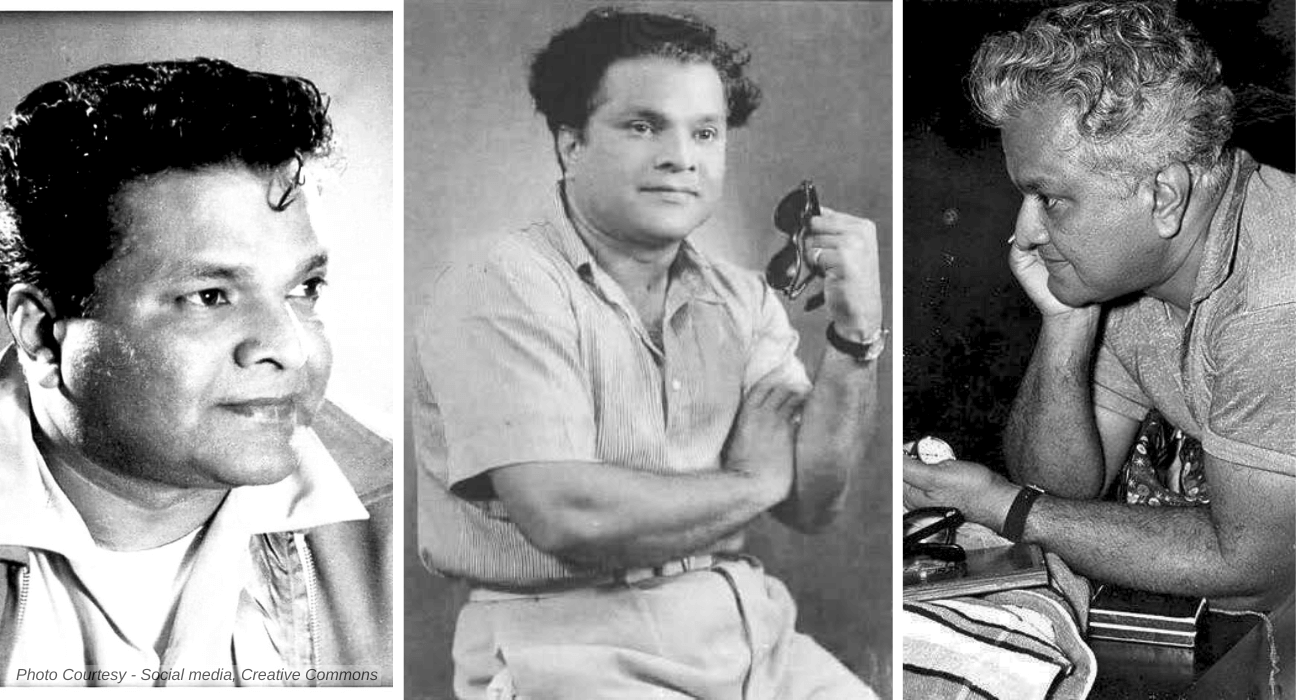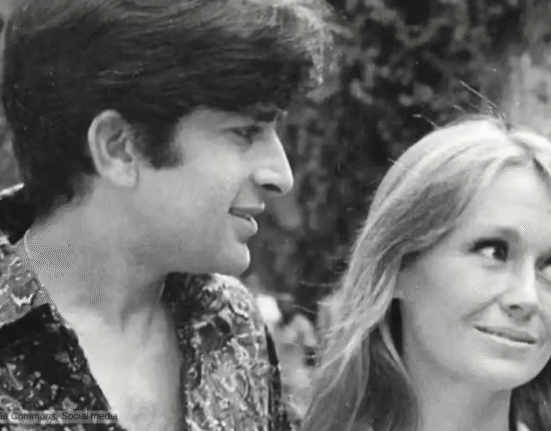Vasant Desai was one of the most accomplished music composers of the golden era of Hindi cinema. He was known for his classical-based, soulful music in films like “Do Aankhen Barah Haath (1953),” “Jhanak Jhanak Payal Baaje (1955),” “Goonj Uthi Shehnai (1959),” “Sampoorna Ramayan (1961), “Aashirwaa” (1968), and Guddi (1971).
Early Life and Career
Vasant Desai was born on June 9, 1912, in Sonawade village, Sindhudurg district, Maharashtra. Originally named Atmaram Desai, his paternal uncle Vishnu Desai changed his name to Vasant. His father, Krishna Desai, deserted the family, leaving Vasant’s mother, Muktabai, to raise him. Muktabai, daughter of the renowned kirtankar Baba Bhaskar Parulekar, relied on her father’s support after Krishna’s abandonment.
Vasant grew up in Kudal, a nearby area in the Konkan belt. The family faced many challanges due to his father’s absence. Muktabai used to sing devotional songs which influenced Vasant’s early musical exposure. He had two brothers, including Achyut, 14 years his senior, who later moved to Droog near Nagpur after marriage.
Vasant’s formal education ended after the fourth standard. His mother sent him to his great-grand-uncle, Raghunath Desai, in Kudal to study, but Vasant’s passion lay elsewhere. He joined a local folk theatre group, honing his skills in singing and acting.
Vasant Desai – The Actor-Singer
At 16, he moved to Kolhapur, a cultural hub, to pursue his interests. Vasant Desai entered the film industry in 1929 through the Prabhat Film Company in Kolhapur. A cousin, Ghanshyam Desai, introduced him to filmmaker V. Shantaram, who hired him as an unpaid office boy. After a year, Shantaram moved him to the acting department. Desai started his career as an actor in Prabhat Film Company’s Khooni Khanjar (1930). He also sang for All India Radio and performed at music conferences.
He then sang a few songs, starting with “Jay Jay Rajadhiraaj” in “Ayodhaya Ka Raja (1932).” One more notable song that he sang was the popular Kajri “Barsan Laagi” in “Amrit Manthan (1934).” Due to not getting suitable roles in films, he decided to concentrate on his music career and composed songs in Prabhat’s films like “Dharmatma (1935)” with music director Master Krishnarao and “Sant Dnyaneshwar (1936)” with music director Keshavrao Bhole. He also sang the song “Aaj Bhaag Jaag Gaye Logo Hamare” in Dharmatma, “Kaaraj Ki Jyot Sada Hi Jare” in Amar Jyoti, “Kaaraj Ki Jyot Sada Hi Jare” in Sant Sakhu, and “Hai Duniya Mein Paap Ghulami” in Wahan.
Transition To Music Direction

It was the time when he realised that, to become a good musician, he needed training in classical music. Vasant Desai started his training in classical music under Ustaad Aalam Khan and Ustaad Inaayat Khan of the Dagar Brothers, learning Dhrupad Dhamar and classical music. He continue to learn the music and the craft of music composition for the next several years.
His first Hindi film as an independent composer was Wadia Movietone’s “Shobha” in 1942, followed by “Ankh Ki Sharm (1943)” and “Mouj (1943).” He left Prabhat Films and joined Rajkamal with V. Shantaram. In 1943, the film “Shakuntala” opened the doors of success for him. It was a huge musical hit, and he became an important part of Rajkamal.
Throughout the 1940s, he continued to compose for films like “Parbat Ke Apna Dera (1944),” “Subhadra (1946),” “Jeevan Yatra (1946),” “Matwala Shair Ram Joshi (1947),” “Udhaar (1949),” and many more.
Vasant Desai and V. Shantaram
His collaboration with V. Shantaram resulted in iconic films like “Dr Kotnis Ki Amar Kahani (1946),” Dahej (1950), Sheeshmahal (1950), Jhanak Jhanak Payal Baaje (1955), Toofan Aur Diya (1956), and Do Aankhen Barah Haath (1957), which are now considered classics. Desai worked very hard for the music of these films; he used pure classical, folk, and thematical music perfectly for these films. Jhanak Jhanak Payal Baaje was purely based on a dance theme, so he composed classical dance tunes. He used the voice of great vocalist Ustaad Amir Khan for the title song of the film.
Some of his notable songs in include Pareshan Hoon Ki Kyon Meri Pareshani Nahin Jaati ( Parbat Pe Apna Dera), Chit Dole Nit Dol (Dr. Kotnis Ki Amar Kahani), Aa Ja Nigahon Mein Aa Ja (Dahej), Jise Doondhti Phirti Hai Meri Nazar (Sheesh Mahal), Dua Hai Yeh Jale Dil Ki (Anand Bhavan), “Jhanak Jhanak Payal Baaje,” “Nain So Nain Naahi Milao,” and “Saiyan Jao Jao Mose Naa Bolo,” (Jhanak Jhanak Payal Baaje), “Nirbal Se Ladaai Balwaan Ki Yeh Kahani Hai Diye Ki Aur Toofan Ki” (Diya Aur Toofan), “Ae Malik Tere Bande Hum,” “Saiyan Jhoothon Ka Bada Sartaj Nikla,” and “Tak Tak Dhoom Dhoom Tak” ( Do Ankhen Barah Haath), Dil Hum To Haare (Ardhangini), “Chhum Chhananana Bichhua Bole Re” (Do Behnen) and many more.
His relationship with V. Shantaram comes to a standstill when V. Shantram decides to drop Vasant Desai from Navrang (1956) and chooses C. Ramchandra in place of him, which leaves Desai’s heart broken.
Vasant Desai The Genius
He did a comparatively lesser number of films after that, but he managed to maintain the style and melody of his tunes. The use of classical music was clearly visible in his music in this era. The period saw the release of Mausi (1958), Ardhangini (1959), Goonj Uthi Shehnai (1959), School Master (1959), Sampurna Ramayan (1961), Yaadein (1964), Bharat Milap (1965), Ladki Sahyadri Ki (1966), Ram Rajya (1967), Ashirwad (1968), Guddi (1971), and Rani Aur Laal Pari (1975).
Sunil Dutt‘s Yaadein (1964) was a milestone, not only in Vasant Desai’s career but in Hindi films at large. It was a movie with only one artist. The story was portrayed with the help of background music and dialogue. It was a big task for Vasant to compose the music for it, yet he came out with a perfect background score and a perfectly composed “Dekha hai sapna koi” sung by Lata Mangeshkar.
Some other notable songs of Vasant Desai in his later career are “Dil Ka Khilauna Haay Toot Gaya,” “Jeevan Mein Piya Tera Saath Rahe,” “Kah Do Koi Na Kare Yahan Pyar” (Goonj Uthi Shehnai), “Mere Godi Mein Gopala” (Pyar Ki Pyas), “Ek Tha Bachpan,” “Rail Gaadi Rail Gaadi Chhuk Chhuk” (Ashirwad), “Bole Re Papihara,” “Humko Man Ki Shakti Dena,” “Hari Bin Kaise Jiyoon Ri” (Guddi), Bikhre Taar Mile Phir Man Ke (Grahan), and many more.


Other Work
Later, in 1974, when Gulzar made “Achaanak,” a songless film, he called it Vasant Desai for its music. The film has a great scope for background music, and Gulzar knew that Vasant was the perfect man for the job. He also did background scores for the films “Zalzala,” “Ferry,” and “Kabhi Andhera Kabhi Uajala.”
Vasant Desai used the voice of veteran Ashok Kumar for his 1968 film Aashirwaad. ‘Railgadi Railgadi’ by Ashok Kumar is perhaps Hindi film’s first ‘Rap song’. He composed the song “Ek thaa bachpan,” sung by Lata Mangeshkar in Raag Pooriya Dhanashri. He composed “Jeevan Se Lambe Hai Bandhu,” sung by Manna Dey in Raag Shiv Ranjini.
Vasant Desai introduced Vani Jayram in “Guddi (1970)” as a playback singer. “Bole Re Papihara,” sung by Vani, is one of the few remembered rain songs to date. He introduced Dilraaj Kaur in “Rani Aur Laalpari (1975)” as a playback singer. One of Vasnat Desai’s most famous songs was Doordarshan’s “Ek Chidiya Anek Chidiyan,” The song is a rare gem, sung by his disciple, a young “Sadhna Sargam.”
Personal Life and Later Work
Vasant Desai never married and had no children. From 1956, he lived with his nephew Vikas Desai’s family at their Peddar Road bungalow in Mumbai. He also owned a place in Shivaji Park. Vikas, who later became a filmmaker, shared a close bond with Desai, accompanying him to recording studios from age five.
Maithreem Bhajata is a benediction composed in Sanskrit by Sant Jagadguru Shri Chandrasekharendra Saraswati of the Kanchi Mutt. Vasant Desai set the song to a Ragamalika. Bharat Ratna Smt. M. S. Subbulakshmi sang it at the United Nations on October 23, 1966, on the occasion of UN Day.
In Marathi, some of Desai’s memorable songs are “Sanga mukund kuni ha pahila,” “Uthi uthi Gopala” from Amar Bhoopali (1951), “Manuskichya shatrusange yuddha amuche suru” from Chota Jawan (1963), “Deh devache mandir” from Preeti Sangam (1972), “Ramya hi swargahuni Lanka” from Swayamwar Zale Siteche (1974), and many more.
Death and Legacy
Vasant Desai composed music for only 46 films but always gave his heart and soul to the project and never ever diverted from his classical music base. His favourite poets were Majrooh Sultanpuri, Kavi Pradeep, Gulzar, Pt. Narendra Sharma and above all, Mahakavi Bharat Vyas.
On December 22, 1975, after a recording session for a government program, Desai died in a tragic elevator accident at his Mumbai apartment. The lift malfunctioned, crushing him to death. He was only 63.
Vasant Desai’s extensive and remarkable collection of songs is a valuable gem of musical heritage. Although he may not have received widespread recognition for his contributions to cinema and school music curriculum, Desai’s songs continue to delight listeners with their inherent melodic beauty and classic finesse.
Vasant Desai on IMDB









